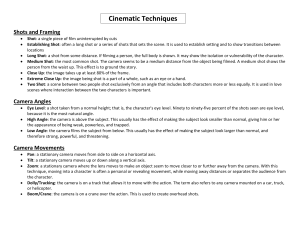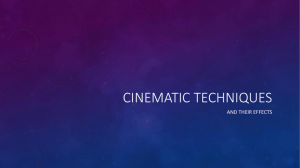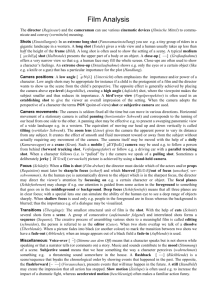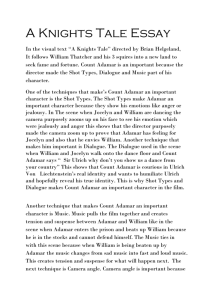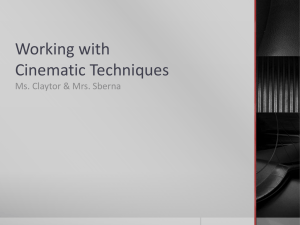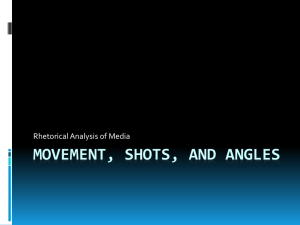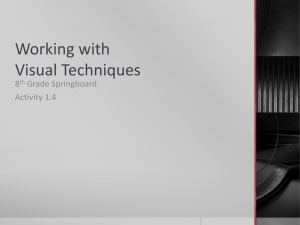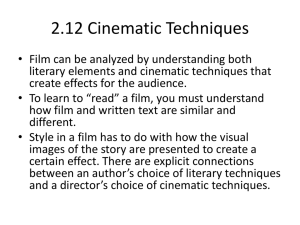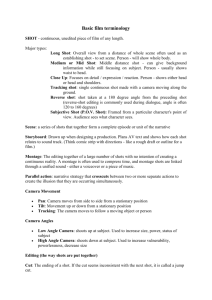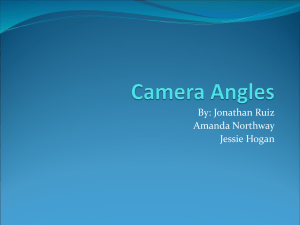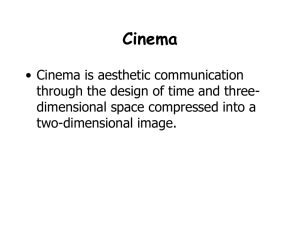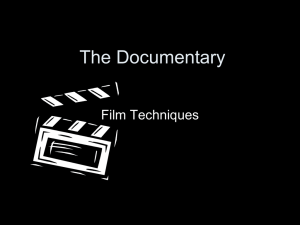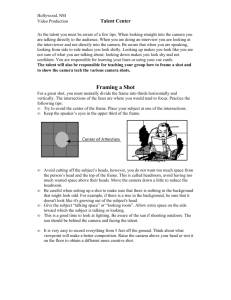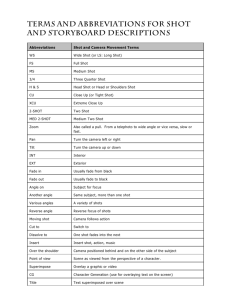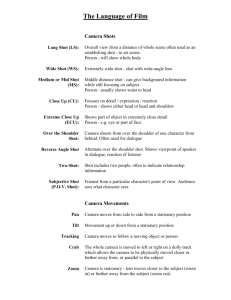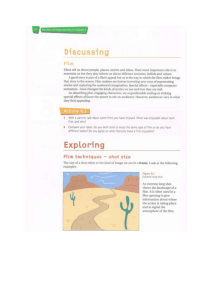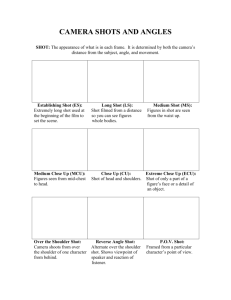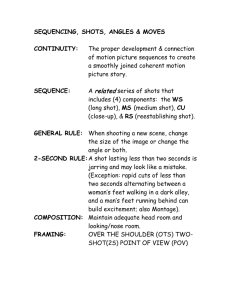Film Terminology
advertisement
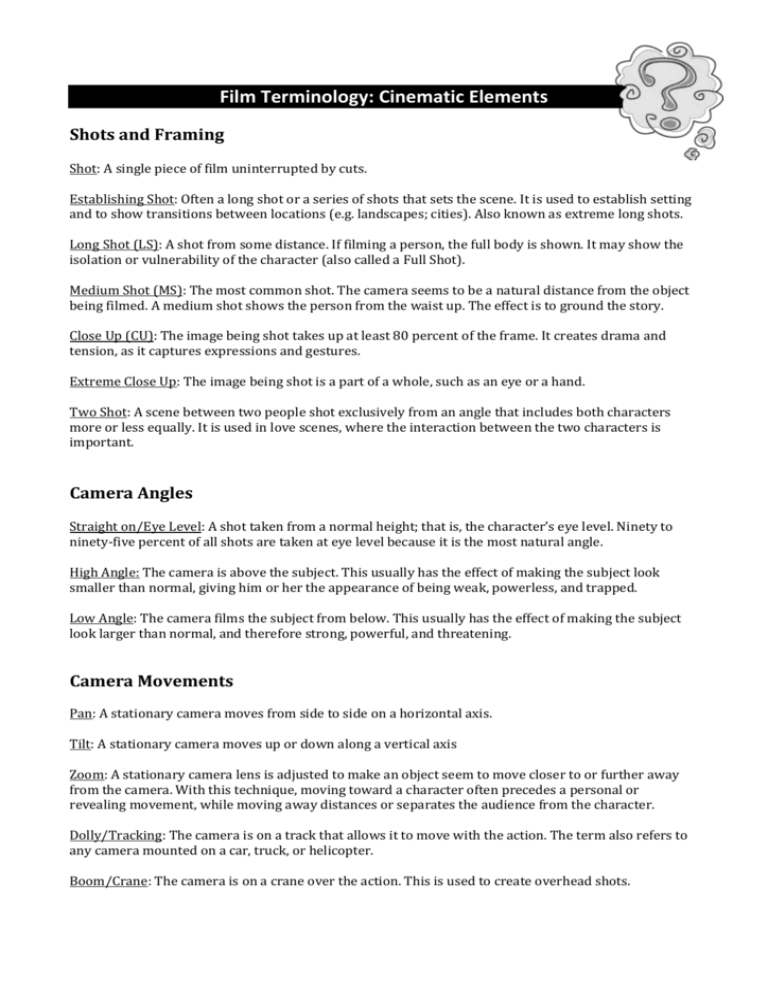
Film Terminology: Cinematic Elements Shots and Framing Shot: A single piece of film uninterrupted by cuts. Establishing Shot: Often a long shot or a series of shots that sets the scene. It is used to establish setting and to show transitions between locations (e.g. landscapes; cities). Also known as extreme long shots. Long Shot (LS): A shot from some distance. If filming a person, the full body is shown. It may show the isolation or vulnerability of the character (also called a Full Shot). Medium Shot (MS): The most common shot. The camera seems to be a natural distance from the object being filmed. A medium shot shows the person from the waist up. The effect is to ground the story. Close Up (CU): The image being shot takes up at least 80 percent of the frame. It creates drama and tension, as it captures expressions and gestures. Extreme Close Up: The image being shot is a part of a whole, such as an eye or a hand. Two Shot: A scene between two people shot exclusively from an angle that includes both characters more or less equally. It is used in love scenes, where the interaction between the two characters is important. Camera Angles Straight on/Eye Level: A shot taken from a normal height; that is, the character’s eye level. Ninety to ninety-five percent of all shots are taken at eye level because it is the most natural angle. High Angle: The camera is above the subject. This usually has the effect of making the subject look smaller than normal, giving him or her the appearance of being weak, powerless, and trapped. Low Angle: The camera films the subject from below. This usually has the effect of making the subject look larger than normal, and therefore strong, powerful, and threatening. Camera Movements Pan: A stationary camera moves from side to side on a horizontal axis. Tilt: A stationary camera moves up or down along a vertical axis Zoom: A stationary camera lens is adjusted to make an object seem to move closer to or further away from the camera. With this technique, moving toward a character often precedes a personal or revealing movement, while moving away distances or separates the audience from the character. Dolly/Tracking: The camera is on a track that allows it to move with the action. The term also refers to any camera mounted on a car, truck, or helicopter. Boom/Crane: The camera is on a crane over the action. This is used to create overhead shots. Film Terminology: Theatrical Elements Lighting High Key: The scene is flooded with light, creating a bright and open-looking scene. Low Key: The scene is flooded with shadows and darkness, creating suspense or suspicion. Bottom or Side Lighting: Direct lighting from below or the side, which often makes the subject appear dangerous or evil. Front or Back Lighting: Soft lighting on the actor’s face or from behind gives the appearance of innocence or goodness, or a halo effect. Editing Techniques Cut: The most common editing technique. Two pieces of film are spliced together so that the film “cuts” from one image to another. Fade: Can be to or from black or white. A fade can begin in darkness and gradually assume full brightness (fade-in) or the image may gradually get darker (fade-out). A fade often implies that time has passed or may signify the end of a scene. Dissolve: A kind of fade in which one image is slowly replaced by another. It can create a connection between images. Wipe: A new image wipes off the previous image. A wipe is more fluid than a cut and quicker than a dissolve. Flashback: Cut or dissolve to action that happened in the past. Shot-Reverse-Shot: A shot of one subject, then another, then back to the first. It is often used for conversation or reaction shots. Cross Cutting: Cuts between actions that are happening simultaneously. This technique is also called parallel editing. It can create tension or suspense and can form a connection between scenes. Eye-Line Match: Cut to an object, then to a person. This technique shows what a person seems to be looking at and can reveal a character’s thoughts. Sound Diegetic: Sound that could logically be heard by the characters in the film. Non-Diegetic: Sound that cannot be heard by the characters but is designed for audience reaction only. An example might be ominous music for foreshadowing.
